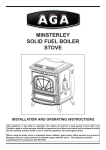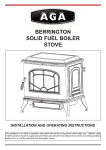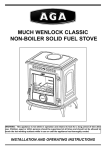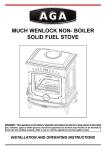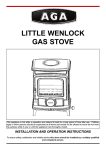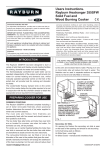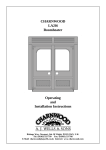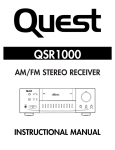Download Rayburn 370 SFW Specifications
Transcript
RAYBURN 370 SFW This appliance is hot while in operation and retains its heat for a long period of time after use. Children, aged or infirm persons should be supervised at all times and should not be allowed to touch the hot working surfaces while in use or until the appliance has thoroughly cooled. When using the cooker in situations where children, aged and/or infirm persons are present a fireguard must be used to prevent accidental contact with the stove. The fireguard should be manufactured in accordance with BS 8423:2002. USER INSTRUCTIONS TABLE OF CONTENTS Page No. 1. 2. Schematic ........................................................................................................................................ 3 Summer Operation.............................................................................................................................4 3. Recommended Fuels .........................................................................................................................4 4. Operation ...........................................................................................................................................4 5. Lighting The Fire ................................................................................................................................4 6. Fuelling...............................................................................................................................................4 7. Condensation .....................................................................................................................................4 8. External Riddling ................................................................................................................................5 9. Ash Removal......................................................................................................................................5 10. Ashpan ...............................................................................................................................................5 11. Thermostat With Override ..................................................................................................................5 12. Overnight Burning ..............................................................................................................................6 13. Firedoor Spin Valve............................................................................................................................6 14. Ashdoor Spin Valve............................................................................................................................6 15. Boiler Insulating Plate ........................................................................................................................6 16. Summer Grate & Heatshield Assy......................................................................................................7 17. Hotplate Covers .................................................................................................................................7 18. Cooking Utensils ................................................................................................................................7 19. Use of Ovens .....................................................................................................................................7 20. Internal Flue Cleaning ........................................................................................................................8 21. Grate Removal ...................................................................................................................................8 22. Cleaning .............................................................................................................................................9 23. Opening Cooker Door ........................................................................................................................9 24. Air Supply...........................................................................................................................................9 25. Cooker Clearance ............................................................................................................................10 26. Chimney Fires ..................................................................................................................................10 27. CO Alarms........................................................................................................................................10 28. Fault Findings...................................................................................................................................11 2 Consumer Protection Act 1987 As responsible manufacturers, we take care to make sure that our products are designed and constructed to meet the required safety standards when properly installed and used. Firebricks, Fuel beds, Fuels - when handling use disposable gloves. Fire Cement - when handling use disposable gloves. In case of skin contact wash immediately with plenty of water. IMPORTANT NOTICE: PLEASE READ THE ACCOMPANYING WARRANTY: Any alteration that is not approved by AGA, could invalidate the approval of the appliance, operation of the warranty and could also affect your statutory rights. Use only authorised replacement parts. Glues and Sealants - exercise caution - if these are still in liquid form use face mask and disposable gloves. Glass Yarn, Mineral Wool, Insulation Pads, Ceramic Fibre, Kerosene Oil - may be harmful if inhaled, may be irritating to skin, eyes, nose and throat. When handling avoid inhaling and contact with skin or eyes. Use disposable gloves, face-masks and eye protection. After handling wash hands and other exposed parts. When disposing of the product, reduce dust with water spray, ensure that parts are securely wrapped. All local regulations including those referring to national and European standards need to be complied with when installing the appliance. Control of Substances - Health and Safety Important This appliance may contain some of the materials that are indicated. It is the Users/Installers responsibility to ensure that the necessary personal protective clothing is worn when handling, where applicable, the pertinent parts that contain any of the listed materials that could be interpreted as being injurious to health and safety, see below for information. Hanlding Adequate facilities must be available for loading, unloading and site handling. Asbestos This stove contains no asbestos. If there is a possibility of disturbing any asbestos in the course of installation then please seek guidance and use appropriate protective equipment. SCHEMATIC 3 1. Blanking Plate 2. 6” Flue Box 3. Trivet 4. Hob 5. Towel Rail 6. Oven Thermometer 7. Main Oven Door 8. Front Cleaning Door 9. Warming Oven Door 10. Base Frame 11. Ashpit Door 12. Boiler Thermostat 13. Riddling Cover 14. Fire Door 15. Hotplate 16. Cleaning Panel to Hotplate 17. Hotplate Covers 18. Flue Damper Fig.1 SUMMER OPERATION (i.e. when Central heating is not in use). The fire-box of this cooker can not be modified to reduce the boiler output while cooking. Therefore if cooking is carried out during the summer months then adequate dissipation of the heat produced be allowed for in your central heating circuit to ensure that the hot water within the circuit does not boil. By-pass Position RECOMMENDED FUELS All fuels should be stored under cover and kept as dry as possible prior to use. This appliance has been tested using manufactured briquetted smokeless fuel (Ancit) for closed appliances, sized between 20g and 140g and wood logs. Other fuels are commercially available and may give similar results. Wood logs up to 380mm long are suitable. All fuels should be stored under cover and kept as dry as possible prior to use. Cooker Position LIGHTING THE FIRE Do not use fuels with a Petro-coke ingredient as this may cause the grate to overheat, causing damage. Reduced outputs will result when fuels of lower calorific values are used. Never use gasoline or gasoline type lantern fuel, kerosene, charcoal lighter fluid or similar liquids to start or freshen up a fire in this heater. Keep all such liquid well away from the heater at all times. Operate the stove only with the fuelling door closed except for re-fuelling. Fully open the thermostat and set the flue damper to by-pass, kindle with paper and sticks in the usual way and ignite by using a taper or rolled wad of paper inserted into the ashpit. Under no circumstances should any inflammable liquid i.e. petrol, paraffin etc. be used to light the fire. When the fire is well established close the direct damper fully and keep it closed. Add fuel to the firebox as required and adjust the thermostat to suit the current requirements. The cooker should not be used as an incinerator. OPERATION FUELLING Before lighting the fire move the flue damper position to ‘by-pass’ this will allow flue gases to the chimney unobstructed, when the fire is established the damper position can be moved to cooker. See Fig.1 When fuelling set the flue damper to by-pass as this will help to eliminate smoking. Afterwards be sure to reset the flue damper to the required setting. Never pack fuel tightly or fill the firebox to capacity. A lower level fire is more effective particularly in regard to water heating efficiency. The maximum fuel level is up to the bottom of the firebox door and rising upwards at a 30o angle towards the back of the firebox. CONDENSATION If the appliance is run for extended periods on a low fire, especially when burning wood or peat the fire can cool down to such an extent that vapour in the flue gases may condense. This will make the inside of the flue damp so that the soot sticks to the flue and the tarry mixture formed may drip down into the appliance. It is always a good idea to run at a high rate 4 whenever possible, because it is so easy to light, a lot of people, especially in the Summer, run the appliance for just a few hours with a strong roaring fire. The appliance is then allowed to die until the hot water is used up and then is relit. From the appliance and flue point of view, this is a better technique than running a low fire continually. (Fig. 1 & 2) ASH REMOVAL Some attention should be paid to the amount of ash that is allowed to build up in the firebox. Wood has better burning characteristics if a bed of ash is allowed to build up, riddling only being necessary to level up the fire (for cooking, for example). Coal or smokeless fuels, on the other hand, burn better if they are well riddled to allow a good airflow to the fire. For slow combustion it is better to have a thicker ash bed for all fuels. Therefore, do not riddle the fire before slowing it down for overnight burning, but riddle it if required in the morning or before cooking. Fig.2 When using anthracite or coal avoid excessive firing conditions. High temperatures are unnecessary and can do serious harm to the cooker. The first indication that overheating is taking place will be the formation of clinker (melted ash) in the firebox and this should be removed immediately otherwise damage will occur to the firebars and cooker components and any damage here should be repaired without delay. ASHPAN The ashpan must be emptied as required otherwise ash will build up to a point where it interferes with the natural flow of cool air through firebars and as a consequence these will be damaged. Fig.3 Fig.4 Riddling Cover Control Knob EXTERNAL RIDDLING THERMOSTAT WITH MANUAL OVERRIDE Lift the riddling cover on the ash door and insert the operating tool into the hole until it engages with the spigot on the grate and move vigorously. In addition it is also recommended that the firebed itself be thoroughly raked at intervals thus loosening up such debris as clinker, stones, etc. which are then easily removed. (Fig.3). The air supply to the fire is controlled by the thermostat probe inserted into the boiler and the control knob attached to the ash door. The automatic thermostat has 6 settings which control the heat to which the boiler water will rise for central heating purposes. Setting 0 will close the thermostat,, setting 3 will give a nominal burning rate of 21/2 to 3kg per hour of house coal. Setting 5 will give maximum water heating and high oven temperatures. 5 The thermostat will close down when the water reaches the temperature chosen by the selected setting, it will close fully when the water temperature reaches 90 - 95o C when set at 5 - to prevent boiling. Heated secondary air enters the firebox through a spin valve in the firedoor back plate while the valve is open to assist combustion of smoke volatiles. Close when burning anthracite. (See Fig.6) (See Fig. 5) ASHDOOR SPIN VALVE The thermostat manual override has 4 settings which retain the air flap in a predetermined open position for steady heat when baking and cooking. It will only close fully when the water temperature reaches 90 95o C when set at 5 - to prevent boiling. The ashdoor spin valve allows additional air to the firebox for marginal draught conditions. This can be adjusted to suit your requirements. Close when setting the cooker for overnight burning. (See Fig.7) Fig.5 Fig.7 Spin Valve BOILER INSULATING PLATE This plate is fitted by removing the hotplate and sliding the insulating plate down between the boiler and oven side. Make sure that the spacing projections are facing the oven and the top flange is resting on the boiler. Replace the hotplate. OVERNIGHT BURNING There is a small air bypass into the ashdoor and this is normally sufficient when the thermostat is closed to hold the fire at least 10 hours after banking. If the fire is out and the fuel unburned set the control knob of the thermostat from 1/2 to 1 in order to sustain overnight burning. The boiler insulating plate may be used with the summer plates or on its own as a means of reducing the boiler output and increasing the heat to the oven. (See Fig. 8) Fig.8 FIREDOOR SPIN VALVE Fig.6 6 2. Insert the support legs (item 1) through the fire door and rest them on the shaker grate support lugs. To lock support legs into position, fit legs as per fig. 15. To obtain a reduction in boiler output during the summer the Cooker is supplied with a removable summer grate and cast iron heat shield plates as standard. 3. Remove the existing rocker grate and stand the summer grate on the supporting legs after inserting it through the firedoor. Fit heat shield plates as shown in diagram. (See fig. 9 & 10) Insert the summer grate (item 2) through the fire door and rest it on the support legs (item 1). 4. Insert the heat shield plates in the following order - items 3, 4 and 5. NB. When using the summer grate and heat shields it will be necessary to use a poker to clear ash before refuelling. SUMMER GRATE & HEAT SHIELD ASSEMBLY INSTALLATION INSTRUCTIONS Fig.9 HOTPLATE COVERS Fig.11 The insulating covers retain most of the heat that would otherwise be radiated into the kitchen. They also retain the heat in the hotplates so that rapid heating of cooking utensils will result when one or both of them are lifted for cooking purposes. (See Fig. 11) Fig.10 COOKING UTENSILS For best cooking results use heavy based, flat bottomed utensils. USE OF OVENS CONTENTS 1. 2. 3. 4. 5. Support legs Summer Grate Back Heat Shield Plate Side Heat Shield Plate Front Heat Shield Plate When baking or roasting, set the flue damper to cooker and open the thermostat fully until the thermometer shows a temperature about 50oF higher than that which is required. Then close the thermostat to a point where the required temperature is sustained (a little practice will soon show how much thermostat adjustment is necessary). Much will depend on the strength of the chimney draught. It will be found that a thermostat setting of 3 will be suitable in most cases. QTY (2) (1) (1) (2) (1) Assembly: 1. Remove the rocker grate through the ashpit door. Brush down the sides of the fire chamber and clean out the debris before fitting the summer grate and heat shields. The main oven is heated on all four faces. The simmering oven is heated on the top face only. The temperature will be about half that of the main oven, for slow cooking, of casseroles, stews, soups etc. 7 Allow cooker to cool down completely, remove all loose sections on top of the Cooker, set the flue damper to by-pass, remove the flue box plate from the flue chamber and remove the cleaning door from the front of the Cooker in order to obtain access. Remove the hotplate cleaning panel and hob cleaning plate, and clean the heat collecting fins on the hotplate. Carbon deposits on these surfaces will reduce efficiency by up to 20%. All deposits from the flue pipe and the top of the oven may be brushed both into the firebox and down the side of the oven. INTERNAL/FLUE CLEANING The flue or chimney will need to be cleaned regularly. How often will depend a lot on how your Cooker is run, but, to start with, make a point of inspecting the flue system every one or two weeks Fig.12 Deposits which have accumulated on the side of the oven must also be brushed downwards. To remove the accumulated ash and soot, thoroughly clean out the residue from the side flues and base plate through the front cleaning door opening — this operation is essential otherwise the flow of hot gases will be obstructed and satisfactory oven temperatures will not be maintained, apart from which such deposits may contribute to smoking. Replace all the loose parts which have been removed making sure that all cooking surfaces have been thoroughly cleaned on the underside. (See Figs. 12, 13 & 14). This period may well be extended as time goes by if there is little sign of deposits. Some people find they need to sweep the flue every six to eight weeks but a longer period is more normal and in some cases this may be as long as 12 months. Fig.14 For most efficient heat transfer to water jacket, all surfaces that come into contact with the flue gases should be kept clean. Regular cleaning will maintain the efficiency of the unit. Use the scraping tool to remove deposits from the inside surfaces of the firebox, the flue ways and top water tube. Regularly look at the top and side of the oven by removing the hotplate cleaning panel and removing the deposits with scraper. To help keep deposits to a minimum, it is a good idea to have a fast fire for 15 minutes at least once a week. Loose deposits will be scoured off and will make the necessity of cleaning out less frequent. GRATE REMOVAL Fig.13 Lift the back of the grate and push it in towards the back of the boiler until the front of the bars pass the front casting. Tilt the grate up on the right hand side, drop down the left hand side towards the back of the boiler and pass the grate through the opening in the front casting, taking care not to damage the enamel. Every week, depending on the type of fuel used, it will be necessary to take off the cleaning access plates to remove deposits. The procedure is as follows: 8 CLEANING OPENING COOKER DOOR IMPORTANT: BE CAREFUL OF THE HOT APPLIANCE. 1. To Open Door Lift handle and pull door open. See Fig. 15. General cleaning must be carried out when the cooker is cool. Fig.15 Stanley cookers are finished in a high gloss vitreous enamel. To keep the enamel in the best condition observe the following tips: 1. Wipe over daily with a soapy damp cloth, followed by a polish with a clean dry duster. 2. If milk, fruit juice or anything containing acid is spilt on the hob or down the cooker, be sure to wipe it immediately or the vitreous enamel may be permanently discoloured. Jam and preservatives containing sugar can permanently damage the vitreous enamel. 2. To Close Door - Lift handle, push door closed, press down to engage latch and release. See Fig.16. 3. Keep a damp cloth to hand while cooking, to wipe up any spills as they occur, so they do not harden and become more difficult to remove later. Fig.16 4. If spills do become baked on, a cream cleanser can be used. For stubborn deposits a soap impregnated pad can be carefully used on the vitreous enamel. 5. Use only products recommended by the Vitreous Enamel Association, these products carry the Vitramel label. 6. In the oven, spills and fat splashes are carbonised at high temperatures: occasionally brush out with a stiff brush. The shelves can be soaked and cleaned with a cream cleanser. NOTE - DO NOT SLAM SHUT THE DOORS AS THIS WILL LEAD TO DAMAGE TO THE DOOR HANDLES. 7. Both insulating covers should be raised and allowed to cool before cleaning the enamel with a soapy damp cloth. Use a wire brush to keep the cast iron hotplate clean. AIR SUPPLY A permanent unobstructed air vent communicated directly to outside air or an adjacent room which itself has a permanent air vent to outside is required. DO NOT USE ABRASIVE PADS OR OVEN CLEANERS CONTAINING CITRIC ACID ON ENAMELLED SURFACES. ENSURE THAT THE CLEANSER MANUFACTURERS INSTRUCTIONS ARE ADHERED TO. Any air inlet grilles must be positioned so that they are not liable to blockage. It is not permissible to use an air extraction device in the same room as the appliance, unless additional ventilation is provided to prevent any adverse effect on the flue. 9 Effect of Extractor Fan Avoid if possible the installation of an extractor fan in the same room as the cooker. Compensating air inlets must be introduced equivalent to the capacity of the fan when fitted. 5. If possible, wet down the roof and other outside combustibles to prevent fires ignited by shooting sparks and flames. 6. Closely monitor all combustible surfaces near the chimney. During severe chimney fires, these surfaces can become hot enough to ignite. COOKER CLEARANCE After a chimney fire, have the chimney inspected by a professional chimney sweep or cooker installer. The Cooker should not be installed at zero clearance to combustible materials. The sides should have a minimum clearance of at least 7.5 cm (3”) from combustible materials unless otherwise fully insulated. CO ALARMS Building Regulations require that whenever a new or replacement fixed solid fuel or wood/biomass appliance is installed in a dwelling a carbon monoxide alarm must be fitted in the same room as the appliance. Further guidance on the installation of the carbon monoxide alarm is available in BS EN 50292:2002 and from the alarm manufacturer’s instructions. This cooker is supplied with a back filler piece which should be used with fitting the cooker between kitchen units. This filler piece is mounted to the wall behind the cooker using the appropriate screws and rawl plugs (not supplied) and allows adequate clearance from the front of the cooker to the front of the kitchen units for door opening (see Fig.5 & 5a) Provision of an alarm must not be considered a substitute for either installing the appliance correctly or ensuring regular servicing and maintenance of the appliance and chimney system. CHIMNEY FIRES Prevention: Chimney fires do not occur in clean, intact, properly installed chimneys. Have a professional chimney sweep clean and inspect your appliance at least once a year. More frequent cleaning may be required, based on the type of fuel burned and the frequency of use. In general, an older appliance or one that is used frequently, will require more than one clean per year. Your installer should have fitted a CO alarm in the same room as the appliance. If the alarm sounds unexpectedly, follow the instructions given under “Warning Note” below. WARNING:If the CO Alarm sounds unexpectedly:- Detection: The first indication of a chimney fire is usually the noise - a roaring sound grows louder as the fire’s intensity increases. Clouds of black smoke and sparks will be seen exiting the top of the chimney; in severe fires, flames can extend several feet about the chimney. 1. Open Doors and windows to ventilate the room and then leave the premises. 2. Let the fire go out. Action: In case of a chimney fire follow these steps but do not put yourself or others in peril: 1. Call the fire brigade immediately. 2. Get everyone out of the property. 3. Close down the air supply to the appliance i.e. the primary air spinner and the flue damper. Limiting the fires air supply will reduce its intensity. If there is a damper in the chimney connector, plug or close the opening. 4. If a fire extinguisher is available, open the appliance door just enough to insert the nozzle of a 10lb, dry chemical fire extinguisher rated for Class ABC fires. Discharge the entire content of the fire extinguisher into the appliance and shut the door. 10 FAULT FINDINGS 1. Poor Chimney Draught (a) (b) (c) (d) (e) 2. Excessive Chimney Draught (a) High Chimney (a) Open Flue Cover of fit Draught Stabiliser 3. Down Draught (a) High Trees (b) High Buildings (c) Negative Pressure Zone (a) Raise Chimney Height (b) Raise Chimney Height (c) Fit Cowl 4. Cooker Smoking (a) (b) (c) (d) (a) (b) (c) (d) 5. Hot Plate Not Heating (a) Soot Under Hot Plate (b) Fire too Low (c) Utensils not Flat (a) Remove and Clean (b) Build better Fire (c) Use machined based Utensils 6. Oven Not Heating (a) (b) (c) (d) Poor Chimney Draught Flueways blocked with soot Damper open to Chimney Faulty Thermostat (a) (b) (c) (d) Raise Height or Fit Cowl Clean Out Close Damper Check and replace if necessary 7. Radiators Not Heating (a) (b) (c) (d) (e) Pump not Working Air in Radiators Pipe System Faulty Excessive Number of Radiators Radiator Valves not adjusted (a) (b) (c) (d) (e) Check and replace if defective Vent Radiators Check Pipe Sizes and Circuit Turn off un-needed Radiators Adjust Valves to give even flow 8. Domestic Hot Water Cylinder not heating (a) (b) (c) (d) (e) Cylinder too Large Flow Pipe too small Flow Pipe crossed Cylinder too far away Hot water from boiler not reaching cylinder (a) (b) (c) (d) (e) Use 135 - 180 L Cylinder Use 25mm Bore Pipe Reverse Flow Pipe Not more than 7.8m fully lagged. Adjust Flow Control Valves or fit injector tee. 9. Intermittent Performance (a) Cooker starved of Primary Air (b) Extraction Fan in room (c) Cooker subjected to wind change (d) Dirty Flueways (e) Poor Fire (f) Uncontrolled Burning (d) Clean Flueways Frequently. (e) Burn more Fuel (f) Repair or Replace Thermostat (a) Leak in Indirect Cylinder Coil (b) Incorrect Cylinder Fitted (a) Replace Cylinder (b) Check with installer 10. Domestic Hot Water Rusty Obstruction Too Low Too Wide Crack in Wall Shared by another unit Insufficient Primary Air Chimney Choked Side Flueways Choked Down Draught (a) (b) (c) (d) (e) Clear and Clean Raise Height above Ridge Fit Flue Liner 15 to 23 c.m. Repair Cracks Cut of other Unit. Provide Room Air Inlet Clean Chimney Clean Flueways Raise Chimney Height (a) Provided Air Inlet in Room. (b) Provide additional Air Inlet in room (c) Raise Chimney of Fit Cowl It is of the utmost importance to keep the flue pipe and chimney clear of deposits by regular sweeping of the chimney irrespective of whether the fuel used is classed as smokeless or not. All fuels give rise to soot or ash deposits and regular cleaning is essential for safe operation. Blocked or partially obstructed flueways and chimneys will cause dangerous fumes to be emitted into the room, these may well be invisible if a smokeless fuel is burned. 11 With AGA Rangemaster’s policy of continuous product improvement, the Company reserves the right to change specifications and make modifications to the appliance described at any time. Manufactured by AGA Rangemaster Station Road Ketley Telford Shropshire TF1 5AQ England www.rayburn-web.co.uk www.agacookshop.co.uk 12












